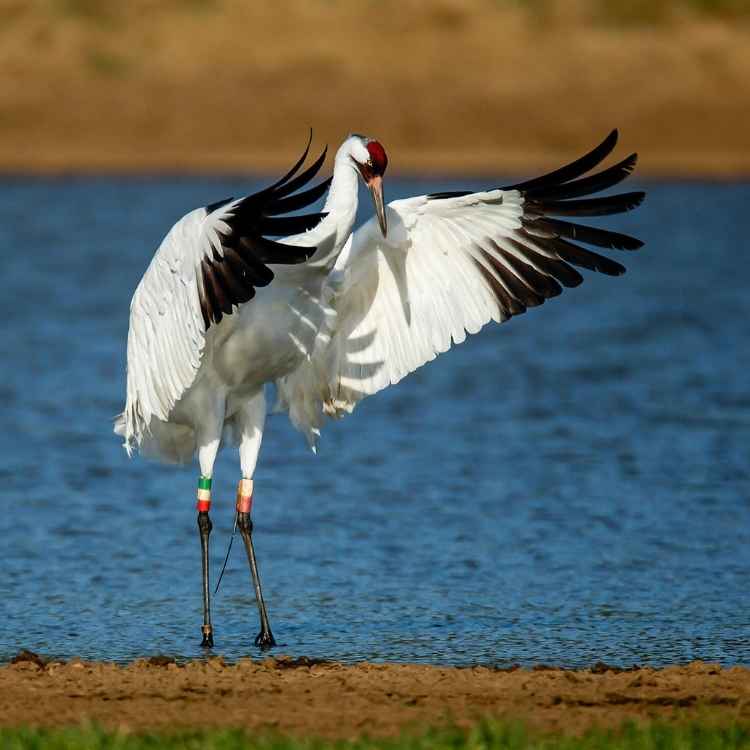Imagine walking by a tranquil lakeside, when a tall, stately bird takes flight. Is it a crane or a heron? While both share striking similarities, the differences are fascinatingly profound. In this article, we’ll unravel the key distinctions ranging from physical traits to habitats and behaviors. Intrigued? Stick around as we delve into the intriguing world of these avian marvels and finally resolve the crane vs heron conundrum!
Table of Contents
Identifying wildlife enriches our appreciation of nature. Start exploring your neighborhood; you’ll be amazed at the biodiversity on your doorstep.

The easiest way to see the difference between a crane vs heron
The most straightforward way to distinguish cranes from herons lies in observing their necks. Cranes typically have shorter necks which they hold erect, a characteristic that’s especially noticeable in flight. On the contrary, herons possess longer necks, which they retract into an ‘S’ shape in flight, whereas cranes maintain their necks straight forward. Additionally, herons generally have longer beaks than cranes.
Even if the bird isn’t airborne and there’s no point of reference for the length of its neck or beak, a lengthy appearance of both indicates a probable heron sighting rather than a crane.
The main differences between Crane Vs Heron when you’re out and about
Physical Stature
Distinguishing between cranes and herons starts with noting the physical stature. Cranes stand taller, adopting a poised, upright posture. Conversely, herons appear more hunched and crouched, creating a more diminutive silhouette.
Practical Tip: When birdwatching, take along a high-quality pair of binoculars to observe the bird’s posture without disturbing it.
Neck Shape and Position
A significant differentiator is the neck shape and position. Cranes have relatively shorter necks that they maintain straight, a feature that becomes more noticeable when they take to the air. In contrast, herons boast longer necks which they retract into a graceful ‘S’ shape while flying.
Practical Tip: The bird’s neck shape and position become more evident in flight, so be patient and wait for the bird to take off.
Bill Size and Shape
The bill size and shape also help in identification. Herons typically have longer, dagger-like bills, designed for spearing fish, their primary prey. Cranes, on the other hand, possess shorter, more robust bills suited to their varied diet.
Practical Tip: A bird guidebook can be invaluable in providing illustrated comparisons of bill sizes and shapes.
Leg Length
The length of the legs is another clue. Cranes’ legs are generally longer relative to their body size, aiding in their ground-based lifestyle. Herons have shorter legs proportionate to their body size.
Practical Tip: If the bird is wading, the length of the legs in proportion to the body can indicate whether it’s a crane or heron.
Wing Shape
Cranes have more rounded, broader wings, while herons have sharper, more angular wings. This difference aids herons in swift, agile flight.
Practical Tip: Observing the bird’s silhouette in flight can provide a clear view of its wing shape.
Flight Pattern
Cranes and herons display different flight patterns. Cranes fly with their necks extended and exhibit steady wingbeats. In contrast, herons fly with their necks pulled back and display slower, more deliberate wingbeats.
Practical Tip: Spend time watching their flight patterns; this patience will pay off incorrect identification.
Call or Song
The call or song of these birds also differs markedly. Cranes tend to produce a loud, trumpeting sound, while herons emit a harsh, squawking noise.
Practical Tip: Consider using a bird song identification app to help distinguish between the various calls and songs.
Plumage Coloration
Herons and cranes differ in plumage coloration, with herons often bearing a grayish-blue color, while cranes tend to be more gray and white.
Practical Tip: A color-accurate bird guide can be a great help in identifying these birds based on their plumage.
Day vs. Night Activity
Cranes are more diurnal, conducting most of their feeding and socializing activities during the daylight hours.
In contrast, some species of herons, such as the Black-crowned Night-Heron, are primarily nocturnal, becoming most active during the night when they hunt for fish and other prey. However, it’s important to note that not all herons are nocturnal; many are active during the day as well.
Practical Tip: The time of day you spot the bird can be a significant clue to its identity. So, consider carrying a flashlight for dusk or dawn birdwatching sessions.
Seasonal Changes in Appearance
Both cranes and herons may show seasonal changes in their plumage, especially during the breeding season. These changes can include alterations in color, pattern, or the presence of special feathers, such as plumes.
For example, during the breeding season, the Great Blue Heron develops long, elegant plumes on its back, while the Sandhill Crane acquires a distinctive red crown.
Practical Tip: Keep in mind the current season and any potential color changes you observe, and compare these with a reliable bird guide to help identify the species.
Social Behavior
The social behavior of cranes and herons is quite distinct. Cranes are often seen in pairs or family groups, a demonstration of their strong lifelong pair bonds.
Conversely, herons are generally solitary outside of the breeding season, preferring to hunt and roost alone. This behavior extends even to nesting sites, where they frequently establish colonies but maintain individual space.
Practical Tip: Observing the bird’s social interactions and behavior, such as whether it’s alone or in a group, can offer significant clues to its identity.
Distribution and Habitat
Cranes and herons inhabit different habitats and have varied geographical distributions. Herons, usually found near bodies of water such as lakes, ponds, and marshes, are widespread across North America. For instance, the Great Blue Heron is seen in every state of the continental U.S. The more exclusive Great White Heron, however, is primarily found in Florida.
Cranes prefer open grasslands, wetlands, and agricultural fields. In the U.S., Sandhill Cranes are found in large numbers in Nebraska, Wisconsin, Florida, and Texas, while Whooping Cranes, one of the most endangered crane species, primarily live in the Aransas National Wildlife Refuge in Texas during winter.
Practical Tip: Being familiar with the common bird species in your specific area can help you quickly identify whether the bird in question is a heron or a crane.
Here’s a table summarizing the key differences between cranes and herons:
| Attribute | Crane | Heron |
|---|---|---|
| Head | Smaller head, red crown on some species | Larger head, some with plumes during breeding season |
| Physical Stature | Taller and heavier | Shorter and lighter |
| Neck Shape and Position | Shorter, held straight | Longer, curved in an “S” shape |
| Bill Size and Shape | Shorter, straight | Longer, often curved |
| Leg Length | Long | Long |
| Wing Shape | Longer, broader wings | Shorter, narrower wings |
| Flight Pattern | Neck straight, legs extended | Neck retracted, legs extended |
| Call or Song | Loud, bugling call | Harsh croaks or squawks |
| Feeding Behavior | Omnivorous, foraging on land | Mostly fish, wading in water |
| Nesting Habitats | Ground or raised platform nests in wetlands | Platform nests in trees or marshes |
| Mating Dances | Complex, coordinated | Simpler, less elaborate |
| Plumage Coloration | Gray, brown, or white | Wide variety, from blue to white, and more |
| Distribution and Habitat | Open grasslands, wetlands, and agricultural fields | Near bodies of water, such as lakes, ponds, and marshes |
| Lifespan | Longer (20-30 years) | Shorter (15-20 years) |
| Social Behavior | Pair-bonded, family groups | Solitary or in nesting colonies |
More differences between the two birds
Body Weight
Cranes are generally heavier than herons, with larger species such as the Whooping Crane weighing up to 16 pounds. Herons, on the other hand, are lighter, with the Great Blue Heron weighing up to 6 pounds.
Practical Tip: Assessing the bird’s size and apparent weight can help distinguish between cranes and herons.
Migratory Patterns
Cranes exhibit migratory patterns, with some species like the Sandhill Crane traveling thousands of miles between breeding and wintering grounds. Herons display less extensive migration, with certain species being mostly sedentary.
Practical Tip: Knowing the migratory patterns of local bird species can inform your identification process.
Reproductive Rate
Cranes typically have lower reproductive rates, laying fewer eggs and raising fewer chicks annually compared to herons.
Practical Tip: Familiarize yourself with the breeding habits of the birds you’re observing to aid in identification.
Diet Variations
Cranes have a varied diet, consuming plants, insects, and small animals, while herons mainly focus on fish and aquatic invertebrates.
Practical Tip: Observing the bird’s feeding behavior and prey can offer valuable insights into its identity.
Predators
Cranes and herons have different predators, depending on their size and habitat. Herons are often preyed upon by birds of prey, while cranes may fall victim to predators like coyotes and foxes.
Practical Tip: Understanding the relationships between birds and their predators can further inform identification efforts.
Threat Status
Some crane species, like the Whooping Crane, face a higher threat status due to habitat loss and human activities. Herons, however, generally have a more stable population.
Practical Tip: Learning about the conservation status of local bird species can foster a deeper connection with the wildlife you encounter.
Adaptation Strategies
Cranes and herons have unique adaptation strategies that aid in their survival. For example, cranes are skilled at using their long bills to forage for food, while herons have evolved specialized neck vertebrae for striking prey.
Practical Tip: Observing these adaptations can help you distinguish between the two birds.
Day vs. Night Activity
As previously mentioned, cranes are mainly diurnal, while some heron species, such as the Black-crowned Night-Heron, are primarily nocturnal.
Practical Tip: The time of day you spot the bird can be a significant clue to its identity.
Size of Clutch (Eggs per Brood)
Cranes typically lay smaller clutches, often one or two eggs per brood, while herons may lay three to seven eggs.
Practical Tip: If you encounter a nest, the number of eggs may help you identify the bird species.
Egg Incubation Period
Cranes generally have longer incubation periods, ranging from 28-35 days, compared to herons, which incubate their eggs for approximately 25-28 days.
Practical Tip: Timing your birdwatching visits around nesting and hatching seasons can provide insight into the bird’s identity.
Juvenile Characteristics
Juvenile cranes and herons display different physical characteristics and behaviors. Juvenile cranes often resemble their parents, while juvenile herons may have different coloration.
Practical Tip: A good bird guide can help you identify juvenile birds by their specific characteristics.
Seasonal Changes in Appearance
As mentioned earlier, cranes and herons show seasonal changes in appearance, especially during the breeding season.
Practical Tip: Keep in mind the current season and any potential color changes you observe.
Table of species of cranes and herons in the states of the US
| Bird Name | States It Can Be Found |
|---|---|
| Sandhill Crane | Nebraska, Wisconsin, Florida, Texas |
| Whooping Crane | Texas, Nebraska, Wisconsin |
| Great Blue Heron | All U.S. states |
| Great White Heron | Florida |
| Little Blue Heron | Southern and coastal U.S. states |
| Green Heron | All U.S. states (mostly in the East) |
| Black-crowned Night-Heron | All U.S. states (mostly in the East) |
| Yellow-crowned Night-Heron | Coastal U.S. states, Midwest |
| Tricolored Heron | Gulf Coast, Atlantic Coast, Florida |
| Reddish Egret | Texas, Louisiana, Florida |
| Snowy Egret | Southern and coastal U.S. states |
| American Bittern | Across U.S. (primarily Northern and Eastern states) |
| Least Bittern | Eastern and Midwestern U.S. |
Belonging to the Ardeidae family, herons are widely distributed across North America, showcasing a variety of species such as the Great Blue Herons, Great White Herons, Little Blue Herons, Green Herons, and Black-crowned Herons.
The majestic Great Blue Heron enjoys a broad range, gracing landscapes from the United States and Mexico to Canada. The Great White Heron, with its stunning white plumage, holds a more exclusive residence, seen only within the confines of Florida. Other heron species, due to their smaller size, are seldom confused with cranes.
The whooping Crane is the biggest bird in North America, at 52 inches tall and soaring up to 7 feet in the air. Additionally, the sandhill crane has a 7-foot wingspan. While herons often reach a height of 46 inches and have a wingspan of up to 6 feet.

The Cranes and Herons carry their heads in a very unique manner. Cranes’ heads, beaks, and necks are proportionately heavier than their bodies, which is why their necks must curve in an “S” shape while they fly. On the other hand, Herons have light necks and fly with their necks extended. Another distinction that may be observed during their flight is that cranes have sharp wing motions and fly with their wings raised above their bodies. Herons have sluggish wing motions and often fly with their wings parallel to their body.
Another difference between the two bird species is that cranes are extremely friendly. They are most frequently spotted away from trees, in large open expanses, and in groups.
Herons prefer a lonely existence. They are frequently sighted alone when hunting or flying. Certain Herons will even attack other Herons if they are displeased with their presence. Herons can be seen perching on forests, marshes, riverbanks, sloughs, meadows, fields, and even backyard ponds. Their social behaviors are obviously quite dissimilar. Herons typically construct single nests, whereas cranes nest in flocks of several hundred of their species.
Herons and Cranes are also distinguished by their coloration. Cranes are predominantly white in color with a black face, black legs, and a darker, slimmer beak than Herons. Herons come in an array of colors. Both Cranes and Herons similarly consume fish, but Cranes dig for food using their beak. On the other hand, herons follow their wetland prey and use tools to lure them in.
Cranes are unique in that they do a dance that no other species performs. Cranes seem significantly different from Herons as they walk slowly in a rolling stroll with their neck stretched straight out.

Interesting facts about Crane
Cranes are huge birds distinguished by their long legs and necks. They have a similar body shape to herons; however, they are slightly larger. The color of a crane is typically characterized as brown, gray, or white; nevertheless, African crowned cranes have an enviable gold crest of feathers on their heads.
The mating dance of the Crane is one of nature’s most spectacular sights. With their wings partially extended, the birds take fast strides around one another, occasionally leaping high into the air. Cranes make a deep bow and stretch their necks during this time.

When males and females aim their beaks at the sky, the male Crane extends a portion of his wing over his back to join the female Crane in their call. The two birds talk back and forth for about ten seconds. According to experts, these screams help to strengthen the bond between a monogamous pair and guard their territory.
Other interesting facts:
- Cranes maintain monogamous pair connections for the duration of their lives.
- Cranes are exceptional flyers, with some capable of flying up to 60 miles per hour over the Himalayas.
- Cranes migrate with their neck and head straight ahead of them, and the rest of their body curled behind them. They can reach altitudes of up to 8,000 meters. Due to the length and difficulty of their voyage, many perish from tiredness, malnutrition, or predation by birds of prey.
- Read more about the crane meaning or further comparisons: stork vs crane, egret vs crane.
Here you can check all Crane sounds
Interesting facts about Heron
Heron’s most often used hunting tactic is to remain still on edge or stand in shallow water and wait for prey to approach. Then, they immediately straighten their S-shaped neck toward the prey. Fish and other prey will be pierced and consumed whole by the sharp bill. Herons have excellent vision and can hunt both day and night.
Herons are superb flyers, capable of reaching speeds of up to 48 kilometers (30 miles) per hour. Their necks are coiled in an S form during flying, and their legs dangle behind the body.
Other Herons Facts:
- Herons may live for up to 20 years.
- Herons from nests in colonies. Their nests are constructed entirely of sticks.
- Although great blue herons appear to be large, they weigh only approximately 6 pounds due to their hollow bones.
- Herons inhabit areas next to the ocean and lakes, and marshes.
- Read more about the heron symbolism.
Here you can check all Heron sounds

